|
PART 1: An Amateur Archivist Surveys Rare Surviving Pages from the World Wide Web of 1994-1996. |
 |
The inevitable passage of time makes reconstructing an accurate picture of the Web's early days very difficult Old and vererable sites disappear and obsolete link lists so predictably yield a dismal skein of 404 Messages that even the most optimistic site researcher is tempted to simply throw her hands up in despair, and loudly bewail the fact that so little remains of the early Web.
This despair is, however, tempered by the fact that a few isolated clusters of miraculously primodial Web content still survive, not in a Hypermedia Museum display case, but on the very same servers upon which they were laboriously constructed back in 1994 or 1995. These old sites often owe their existence less to active preservation efforts than to the same form of benign neglect that lets unused files accumulate on a hard drive without regard to the fact that no application has further use for them.
In this inaugural issue of The Lost Web, Amateur Webleologist Steve Baldwin examines some early surviving Web experiments sighted on a recent tour of major university servers. Like primitive insects preserved in amber, these outdated digital gems function as "living time capsules" of the Web's early days. Their outdated look and feel, experimental spirit, and lack of commercial consciousness all provide an unintendingly clear view of our recent, but rapidly receding electronic past.
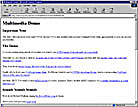 NCSA MOSAIC MULTIMEDIA DEMO It's hard to underestimate the importance of this page. Although it lacks a date stamp, it's clearly a relic of the Web's very earliest days - probably 1993. One need only imagine the gasps, oohs, and ahs this page stirred in Computer Science Labs across America, before anyone had ever heard the terms "inline graphic", "MIME type", or the dreaded "Plug-In".
NCSA MOSAIC MULTIMEDIA DEMO It's hard to underestimate the importance of this page. Although it lacks a date stamp, it's clearly a relic of the Web's very earliest days - probably 1993. One need only imagine the gasps, oohs, and ahs this page stirred in Computer Science Labs across America, before anyone had ever heard the terms "inline graphic", "MIME type", or the dreaded "Plug-In".
Today, of course, it's easy to be underwhelmed by this humble page, and see it for what it is: just a bunch of links to some very randomly chosen multimedia assets (a GIF of Nixon and Elvis, a movie clip from "Terminator", and perhaps most oddly, an audio file of Richard Stallman singing "The Free Software Song" in Japan).
With the benefit of half a decade's worth of hindsight, the NSCA Mosaic Multimedia Demo looks as quaint as a 19th Century Stereopticon. But it's hard to find a page that so charmingly captures the Net's brief transitional moment between text and multimedia, and for this reason, we're overjoyed that nobody has attempted to update this priceless artifact for more than five years.
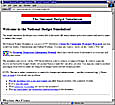 1995 NATIONAL BUDGET SIMULATION Only the most devout historians of the 1995 Budget Debate could truly love this ancient site, which was built by an outfit known as the Economic Democracy Information Network (EDIN), a public-policy group that put it up on Berkeley's servers to let remote users try their hand at Web-based budget tinkering.
1995 NATIONAL BUDGET SIMULATION Only the most devout historians of the 1995 Budget Debate could truly love this ancient site, which was built by an outfit known as the Economic Democracy Information Network (EDIN), a public-policy group that put it up on Berkeley's servers to let remote users try their hand at Web-based budget tinkering.
As expected, the site's budgetary data is seriously obsolete, but its programming still works, which is a testament to the talent of its builders, few of whom probably expected their efforts would outlive all of the political controversy associated with the 1995 Budget.
Those seeking to use the Web for entertainment purposes would do well to take a cue from this site, which eschews bandwidth-hogging multimedia bells and whistles in exchange for fast-loading HTML pop-up windows, which let the user cut right to the chase.
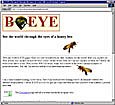 B-EYE: THE WORLD THROUGH THE EYES OF A BEE Back in January of 1995, Andrew Giger, a PhD student at the Australian National University, launched this site, and it's one of the oldest interactive science experiment Web sites still in service today.
B-EYE: THE WORLD THROUGH THE EYES OF A BEE Back in January of 1995, Andrew Giger, a PhD student at the Australian National University, launched this site, and it's one of the oldest interactive science experiment Web sites still in service today.
Users with an interest in bees, bee perception, or neuroscience could (and still can) submit a 2-dimensional image to B-EYE, whereupon the program transforms it into what a bee would see.
Although Giger's subject matter isn't exactly the stuff of mass-market appeal, the site's progressive organization, presentation, and functionality was considered quite a neat feat for its time, and B-EYE was widely linked to in 1995's crop of Hot Links lists, and also picked up its share of awards, including Hotwired's coveted Surf Central award. A vintage example of this long-forgotten icon can be found on B-EYE's home page.
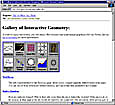 GALLERY OF INTERACTIVE GEOMETRY This charming site appears to date from late 1993 (although modifications were made to it up until sometime in 1997) and like the 1995 Budget Simulator, it continues to work as well today as the day it was FTP'd up to the servers of the University of Minnesota. The site provides users with an interest in geometry a neat way to "design nonperiodic tilings of the plane", "experiment with numerical integration of data sets", "explore the effects of negatively curved space", and perform other geometric miracles without ever having to screech a piece of chalk across a blackboard.
GALLERY OF INTERACTIVE GEOMETRY This charming site appears to date from late 1993 (although modifications were made to it up until sometime in 1997) and like the 1995 Budget Simulator, it continues to work as well today as the day it was FTP'd up to the servers of the University of Minnesota. The site provides users with an interest in geometry a neat way to "design nonperiodic tilings of the plane", "experiment with numerical integration of data sets", "explore the effects of negatively curved space", and perform other geometric miracles without ever having to screech a piece of chalk across a blackboard.
If a site devoted to the same arcane subject matter were built today, it would almost certainly use Java to more graphically convey its interactive message. This old site, however, proves how much information a few forms and some well-crafted CGI can convey.
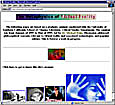 THE METAPHYSICS OF VIRTUAL REALITY This curious-looking, rather wordy site was a product of the Critical Studies Department of the University of Southern California's School of Cinema-Television. It was built to accompany a seminar led by Dr. Michael Heim that ran from January to May of 1995. Although the site states that it is "forever a work in progress", it's obviously not been updated since the time that the seminar ran its course.
THE METAPHYSICS OF VIRTUAL REALITY This curious-looking, rather wordy site was a product of the Critical Studies Department of the University of Southern California's School of Cinema-Television. It was built to accompany a seminar led by Dr. Michael Heim that ran from January to May of 1995. Although the site states that it is "forever a work in progress", it's obviously not been updated since the time that the seminar ran its course.
Beyond its eccentric, free-spirited design sensibilities (which owe much of their charm to their handcraftedness), this site is interesting in terms of its innovative use of the Web as a way to extend the seminar's erudite class discussions into cyberspace. (One can only imagine the joy that must have accompanied the relevation that the Web was a medium with no absolute limit on the amount of post-industrial analysis that could be loaded onto it).
The site's free-ranging discussions often became almost gaseously metaphysical in their own right, especially when Voyager's Bob Stein instigated a spirited thread concerning Microsoft Bob's significance, both as a post-symbolic VR environment, and (perhaps) as an attempt by the software giant to "direct the trajectory of culture".
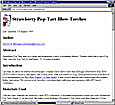 THE STRAWBERRY POP-TART BLOWTORCH PAGE Before sites such as The Onion and Comedy Central established the commercial viability of comedy on the Web, dorm-grown sites such as the Strawberry Pop-Tart Blowtorches page provided early Web users with rich doses of irreverent humor.
THE STRAWBERRY POP-TART BLOWTORCH PAGE Before sites such as The Onion and Comedy Central established the commercial viability of comedy on the Web, dorm-grown sites such as the Strawberry Pop-Tart Blowtorches page provided early Web users with rich doses of irreverent humor.
In a thoroughly convincing, mock-serious manner, this site's author conducted a series of scientific tests demonstrating beyond a reasonable doubt that, at least under certain laboratory conditions, Kellogg's Strawberry Pop-Tarts did indeed begin to function as toaster-mounted blowtorches. And like any good scientist, he rigorously documented each step of his procedures, down to the final disposition of his burned-out testbed toaster in the trash.
Launched in mid-1994, this wacky, pioneering site continues its existence on the servers of Texas A&M's School of Science and Mathematics. It's just about as funny now as it was five years ago, and we hope that the flames of its hilarity are never fully extinguished from the Web's collective memory.
